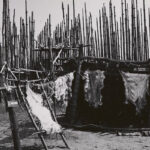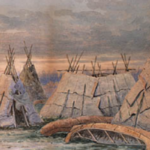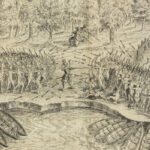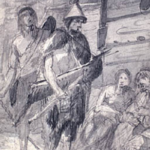Tobique First Nation: A Legacy of Resilience and Connection to the Land
The Tobique First Nation, or Neqotkuk, situated along the banks of the Tobique River in New Brunswick, is part of the larger Maliseet (Wolastoqiyik) Nation. This community, steeped in history and tradition, is a testament to the enduring strength and adaptability of its people. The story of the Tobique First Nation unfolds across thousands of years, from its origins in pre-history through early encounters with European settlers, and into the modern era, where it continues to thrive while preserving its unique cultural heritage.
Pre-History: Wolastoqiyik and the Land
The ancestors of the Maliseet people have lived along the Wolastoq (Saint John River) and its tributaries, including the Tobique River, for over 10,000 years. The Maliseet name, Wolastoqiyik, translates to “People of the Beautiful River,” reflecting their deep connection to the waterways that sustained their way of life. Archaeological evidence from the region points to a sophisticated culture centred around fishing, hunting, and gathering.
The Maliseet were semi-nomadic, with their movements tied to the seasonal availability of resources. Summers were spent along rivers and lakes, where fishing for Atlantic salmon, sturgeon, and eels formed a dietary cornerstone. Winters brought smaller family groups into the forests to hunt moose, caribou, and small game. They supplemented their diet with berries, nuts, and roots, as well as cultivated crops like corn, beans, and squash.
Their environment was not only a source of sustenance but also the foundation of their spiritual beliefs. The Wolastoqiyik viewed the land and waterways as living entities imbued with spiritual power. This respect for the natural world was evident in their practices of sustainable resource management, ensuring that the bounty of the land would endure for generations.
Anthropologist Harold Hickerson, in The Algonquian Peoples of the Boreal Forest, notes, “For the Maliseet, the rivers were not just physical features of the land but sacred pathways that connected their communities, their ancestors, and their spiritual world.”
Governance and Social Structure
The Tobique First Nation, like other Maliseet communities, followed a governance system rooted in consensus and respect. Chiefs, or Sakom, were chosen based on their wisdom, leadership abilities, and capacity to mediate disputes. Decisions were made collectively, with elders playing a crucial role as custodians of oral history and cultural knowledge.
Community life was centred around extended family units, with strong kinship ties ensuring mutual support and cooperation. Oral traditions, passed down through generations, preserved the history, spiritual teachings, and practical knowledge of the people.
First Contact with Europeans
The arrival of European explorers in the early 17th century marked the beginning of a new chapter for the Maliseet of Tobique. The French were among the first Europeans to establish contact, with Samuel de Champlain and other French explorers venturing into Maliseet territory. Early interactions were largely amicable, with the Maliseet providing guidance and resources to the French in exchange for metal tools, cloth, and other goods.
The fur trade quickly became a cornerstone of Maliseet-European relations. The Tobique River, a tributary of the Saint John River, played a vital role in this burgeoning trade network. The Maliseet trapped beaver, otter, and other fur-bearing animals, which they traded for European goods. This trade introduced new technologies that enhanced traditional practices but also disrupted local economies and ecosystems.
The arrival of Europeans also brought devastating consequences. Epidemics of smallpox, measles, and other diseases to which the Maliseet had no immunity swept through their communities, causing significant population declines.
Relationships with Missionaries and Settlers
French missionaries, particularly Jesuits, established missions among the Maliseet during the 17th century. These efforts sought to convert the Maliseet to Christianity, often clashing with traditional spiritual beliefs. While many adopted aspects of Christianity, they integrated these teachings into their existing worldview rather than abandoning their traditions entirely.
The Maliseet of Tobique forged strong alliances with the French, supporting them in conflicts with the British, such as King William’s War (1688–1697) and the Seven Years’ War (1756–1763). These alliances were rooted in shared economic interests and mutual opposition to British expansion.
The British conquest of New France in 1763 brought significant changes to Maliseet territory. British policies, often dismissive of Indigenous sovereignty, led to encroachments on Maliseet lands and resources. Despite these pressures, the Maliseet of Tobique adapted, maintaining their cultural practices while navigating the challenges of British rule.
The 19th Century: Encroachment and Resilience
The 19th century brought increasing settlement and industrial development to the Saint John River region, further disrupting Maliseet life. Logging, farming, and other industries encroached on traditional hunting and fishing grounds, threatening the Tobique First Nation’s way of life. The establishment of reserves under the Indian Act (1876) confined the Maliseet to smaller portions of their ancestral lands, limiting their mobility and access to resources.
Despite these challenges, the Tobique First Nation demonstrated remarkable resilience. Seasonal trips into the forest allowed families to continue hunting, fishing, and gathering, preserving traditional practices. The Wolastoqiyik language and oral traditions remained central to community life, ensuring that cultural knowledge was passed down to future generations.
Cultural Revitalization and Language Preservation
The Tobique First Nation has worked tirelessly to preserve its language, Wolastoqey, and cultural traditions. Efforts include language immersion programs, cultural workshops, and community events that celebrate Maliseet heritage. The annual Tobique Powwow, featuring drumming, dancing, and storytelling, provides an opportunity to reconnect with traditions and strengthen community bonds.
Traditional crafts such as birchbark canoe-making, beadwork, and basketry are celebrated as symbols of Tobique’s ingenuity and resilience. These practices, passed down through generations, are not merely cultural artifacts but living traditions that connect the community to its past and future.
Environmental Stewardship and Advocacy
The Tobique First Nation has long been a steward of the Tobique River and its surrounding ecosystems. Traditional ecological knowledge informs their approach to hunting, fishing, and land management, ensuring that these practices remain sustainable.
Modern challenges, such as industrial pollution, climate change, and habitat loss, have heightened the need for advocacy. The Tobique First Nation has taken an active role in addressing these issues, partnering with environmental organizations and governments to protect the river and its resources. These efforts reflect their commitment to preserving the land for future generations.
Tobique Today: A Thriving Community
Today, the Tobique First Nation is a vibrant and dynamic community of approximately 2,000 members. Investments in education, healthcare, and infrastructure reflect their commitment to creating opportunities for future generations. Cultural tourism, including guided tours and participation in traditional activities, has become an important part of the local economy, showcasing the community’s rich heritage.
The Tobique First Nation also plays a leadership role in regional governance, advocating for Indigenous rights and environmental sustainability. Their efforts highlight the enduring strength of the Wolastoqiyik people and their ability to adapt while honouring their traditions.
Conclusion: A Legacy of Strength and Continuity
The history of the Tobique First Nation is a testament to their resilience, adaptability, and deep connection to the land and waterways of the Tobique River. From their ancient presence along the Wolastoq to their central role in early European trade and their modern efforts in cultural revitalization and environmental advocacy, the Maliseet of Tobique have maintained their identity and place within Canada’s evolving landscape.
As an elder from Tobique once said, “The river is our lifeblood, connecting us to our ancestors and guiding us toward the future. By protecting our traditions and our land, we ensure that our story continues.”
References
- Hickerson, Harold. The Algonquian Peoples of the Boreal Forest. McGill-Queen’s University Press, 1973.
- Whitehead, Ruth Holmes. The Old Man Told Us: Excerpts from Micmac History, 1500–1950. Nimbus Publishing, 1991.
- Jesuit Relations. Documents of the Missions to New France. McGill University Press, 1962.
- Conrad, Margaret. A Concise History of Canada. Cambridge University Press, 2012.
- Environmental Justice Advocacy Group. Stewardship and Sovereignty: The Role of the Maliseet in Environmental Advocacy. University of Guelph Press, 2019.
- Tobique Cultural Centre. Guardians of the River: The History and Culture of Tobique. Tobique Publications, 2015.
- Ridington, Robin. Trail to Heaven: Knowledge and Narrative in a Northern Native Community. Douglas & McIntyre, 1988.
- Johnston, Basil. Ojibway Heritage. McClelland & Stewart, 1976.
- Snow, Dean R. The Iroquois. Blackwell, 1994.
- Neeposh, Thomas. “Protecting Our Future: The Vision of Tobique First Nation.” CBC News, 2021.



